One night in February 2013, Chris Peters stepped into his backyard with his dog, a petite Maltese named Cujo. Peters, who lives in a tony east-end Toronto neighbourhood called the Beach, couldn’t let Cujo out unsupervised; several years earlier, residents began noticing a coyote loping through the ravine behind their homes. Charmed, some gave it a name—Neville, after Neville Park Boulevard, the cul-de-sac where it spent most of its time—and even fed it boiled chicken. Neville was featured in the local newspaper, and neighbours swapped stories about sightings. But as the coyote grew bolder, others became wary. “It has come up onto people’s decks and looked through the sliding glass doors,” Mary Lou Leiher, a program manager at Toronto Animal Services, said. “That is not normal.”
Then the inevitable happened. Neville killed a chihuahua in 2009 and was implicated in a few other pet attacks. Cats disappeared. Animal Services hired a trapper, who tried and failed to catch the culprit. Animal-rights activists got involved, pressuring officials not to kill Neville, and the neighbourhood struck a détente. Meanwhile, at least one other coyote moved in. Peters awoke to their sounds at night—those eerie, iconic howls—and spotted their tracks in the snow.
That February evening, as Peters waited for Cujo to do his business, he saw a flash of movement from a neighbour’s yard. Before he had time to react, a coyote—smaller than Neville, possibly its mate—snatched Cujo in its jaws and sprinted into the trees. Peters chased after it. His son heard him yelling and came running. They stood there helplessly, calling Cujo’s name. Then they spotted the dog, limping back up the hill. “The coyote had bitten the shit out of him, but he was still on his feet,” Peters said. He cradled the dog in his arms and raced to a nearby vet. It was clear, though, that Cujo wasn’t going to make it; the coyote’s teeth had drilled too deep. Peters had to put the dog down.
A month later, the city held a heated public hearing on coyotes in the Beach. “That got a bit raucous,” Peters told me. “There were people who kept saying, You can’t take away our coyote, and other people saying, Well, you shouldn’t be feeding it.” Animal Services encouraged residents to report their neighbours if they were caught feeding the creatures but declined to do anything else unless humans were in danger, which frustrated Peters. “Why is the city not considering this a threat to public safety? ” he said. “Until someone is actually bitten in the area by a particular coyote, a threat to public safety doesn’t exist—which is ridiculous.” There are still coyotes in the neighbourhood. Peters paints as a hobby; one of his recent works depicts a coyote, silhouetted against a wash of reds and yellows, creeping through a stand of trees. A small white dog huddles in the foreground.
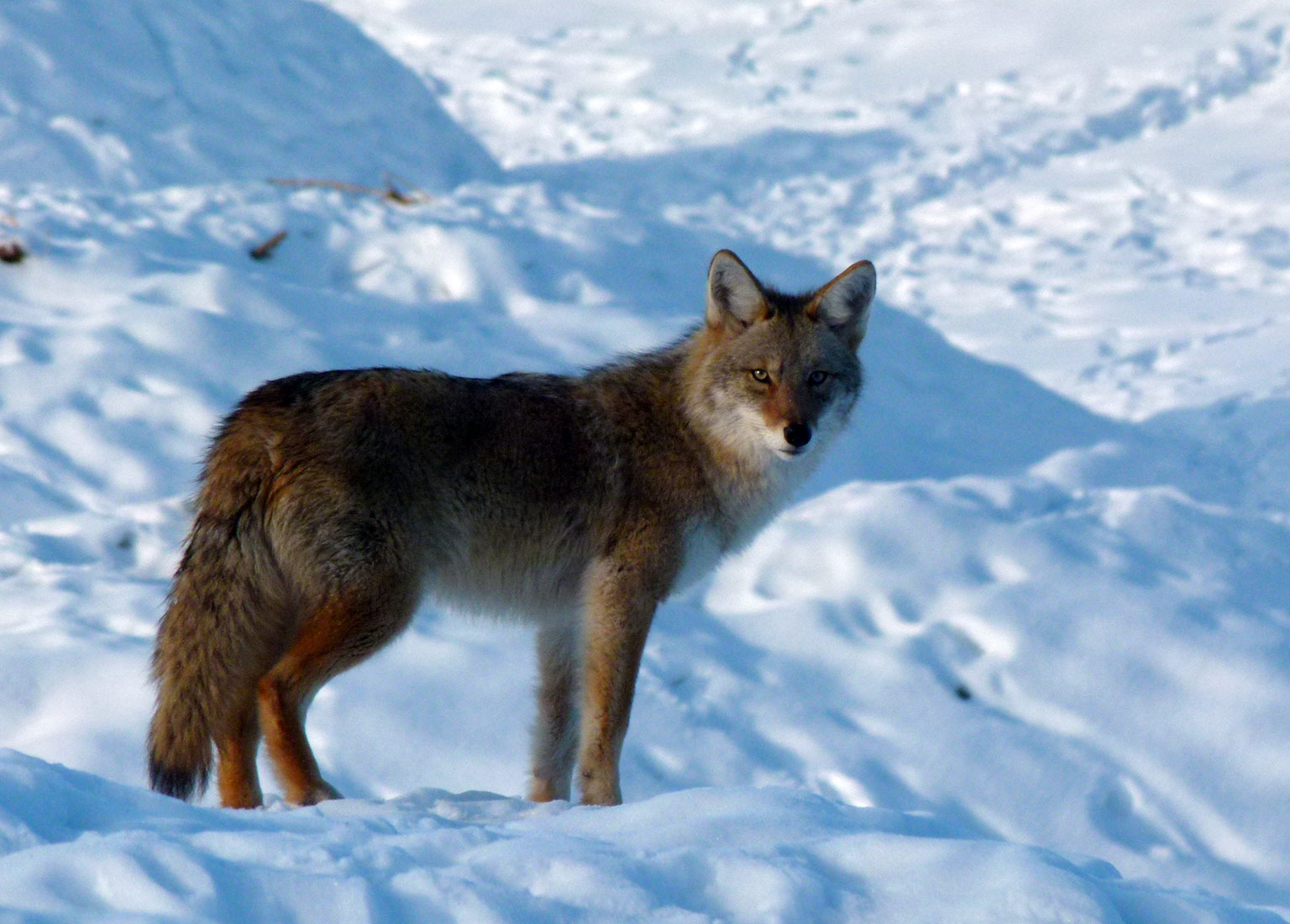
The twenty-first century belongs to the urban coyote. Almost every major city in North America now hosts a considerable population, as do countless smaller towns and suburbs. Firm numbers are hard to come by, but Colleen St. Clair, a biologist at the University of Alberta, estimates Edmonton’s at 500 or 600. According to Stanley Gehrt, of Ohio State University, there are at least 2,000 in the Chicago area, though he cautions that that number is both conservative and years out of date. They live as far north as Alaska and as far south as Central America; last year, scientists confirmed for the first time that the animals have crossed the Panama Canal. They dwell on the West Coast and the East Coast and nearly everywhere in between. In March, a confused coyote was photographed on the roof of a bar in Queens, New York.
Sometimes—rarely, but sometimes—coyotes attack humans. A 2009 study co-authored by Gehrt confirmed a total of 142 attacks on humans in the US and Canada between 1960 and 2006. There are only two known fatal incidents in modern history: one in 1981 that involved a three-year-old girl in a Los Angeles suburb; the other in 2009, when a pack in Cape Breton, Nova Scotia, killed a nineteen-year-old singer-songwriter. Most run-ins are less severe. In 2012, when a five-year-old girl was bitten in an Oregon state park, she told a local website, “I only feeled his teeth.”
Conflict is on the rise because coyotes are losing their fear of us. “Thirty, forty years ago, just the smell of a human being would have raised an alarm with a predator like a coyote,” Bill Abercrombie, a trapper in Alberta, told me. “Not anymore.” Gehrt’s study found that the majority of attacks take place near homes or in parks, with the animals having grown accustomed to seeing people as a food source. One man was bitten while feeding a coyote by hand. It would be reassuring to think these incidents happen only when the animals feel threatened, but that does not seem to be the case. When coyotes bite people, it is rarely in defence: 37 percent of the time it’s predatory, and 22 percent of the time it’s “investigative”—a test run on a potential human meal. Most victims of predatory attacks are children; in addition to being smaller and more vulnerable, children may stimulate a predatory response by running and playing.1
Coyotes have long skulked at the edges of human development, playing an ambivalent role in the imagination: trickster, menace, pest. They are liminal creatures, dwelling in the cracks of the world. This is what gives them the upper hand. Now, for the first time in history, the majority of the human population lives in urban areas, and the coyote’s movement into the city has paralleled our own. There is something magical about this—the rangy emblem of the western frontier at home in the downtown park and the quiet suburban lane. But part of that magic comes from the fact that coyotes are a little bit scary, and debates over what to do about them sometimes get ugly. Earlier this year, six coyote carcasses were found scattered across the London, Ontario, area. The bodies were deliberately laid out in public spaces, as if on display. Two were decapitated. “People love the animals until they cause them some grief,” Abercrombie said. “Then they want to kill them all.”
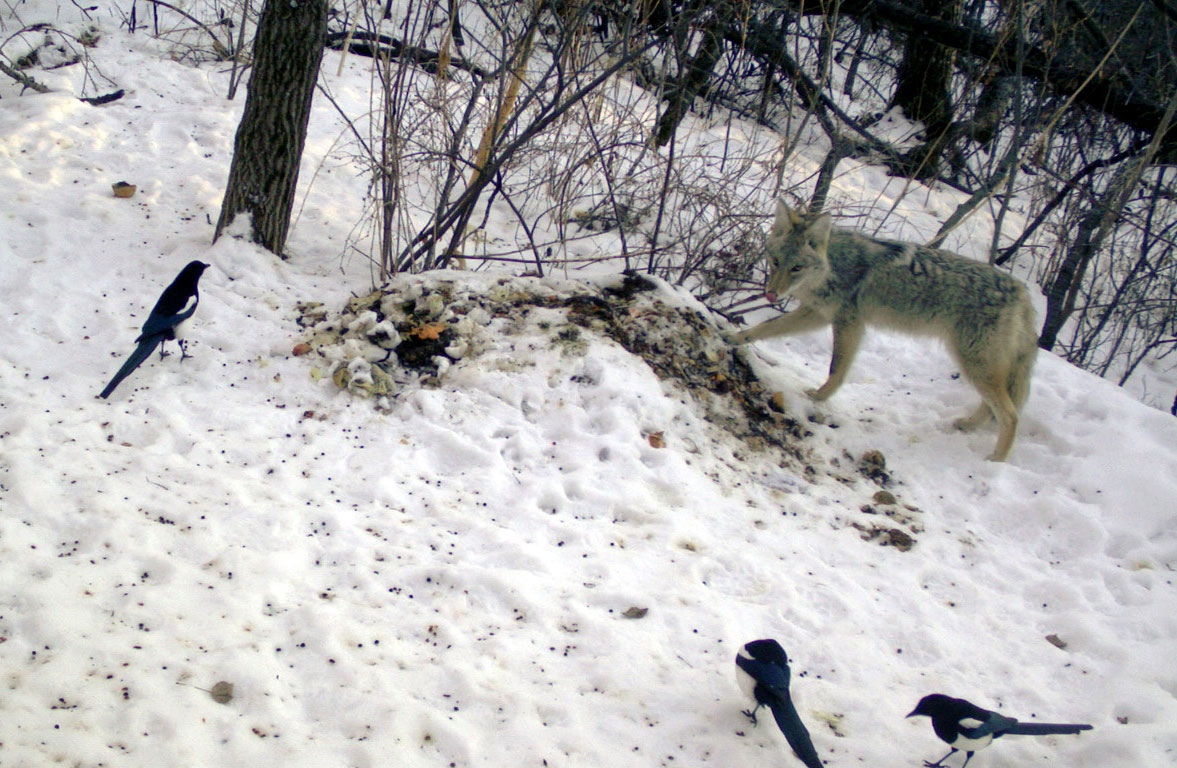
Over the past several decades, urban wildlife populations have exploded. “We have left no stone unturned in our fight against the Raccoon Nation,” Toronto mayor John Tory declared in April, as he unveiled a new, supposedly animal-proof compost bin. Municipalities everywhere are struggling to manage huge numbers of white-tailed deer. In British Columbia, black bears rooting through the garbage are a fact of suburban life. For nearly three years, a cougar dubbed P-22 has lived in Griffith Park—home of the Hollywood sign—in the middle of Los Angeles.
The rise of urban wildlife is an environmental success story to which we are unaccustomed: natural resilience in the face of human onslaught. We have razed forests, cooked the planet, wiped out species at a rate that would make an asteroid blush—and yet, somehow, we haven’t killed everything. Instead, counterintuitively, we have created conditions for unprecedented flourishing. This has a lot to do with the way we began to design urban areas after World War II. Suburban sprawl is endlessly maligned for its wasteful low density, its reliance on the automobile, and its monocultural aesthetic. But the growth of this in-between space—neither fully urban nor fully rural—resulted in its own kind of habitat. “Sprawl dwellers planted grass, trees, shrubs and bushes, and flower and vegetable gardens,” Jim Sterba writes in his 2012 book, Nature Wars. “They created backyard habitats with ponds and native plants, and put out food so they and their children could observe, firsthand, any wild creatures that might turn up.” Attracted by fewer predators, abundant food, and ample shelter, the species that evolution had shaped into scrappy opportunists—rodents, skunks, deer—followed humans into the burbs.2
At the same time, after centuries of environmental destruction, people began to think differently about nature. Eastern North America saw enormous levels of quiet reforestation. The demise of the family farm, the decline of hunting and trapping, and the dwindling popularity of fur meant that animals once killed on sight were now considered harmless, even adorable. Many municipalities enacted rules against hunting and firearm use. Pro-wildlife citizens’ groups cropped up, opposed to the killing of so-called nuisance animals. As populations recovered, competition for resources pushed wildlife into novel habitats. By the 1990s, many big cities were seeing befuddling numbers of coyotes, raccoons, and other species.
Perhaps most importantly, those cities were also becoming greener. Urban parks transformed from manicured, lawn-like expanses into verdant, semi-wild habitats. Many cities now have “greenbelts” surrounding their suburbs and urban centre; in southern Ontario, for example, a coyote such as Neville could trot from the Greenbelt through a series of train tracks, parks, conservation areas, and golf courses, eventually leading into popular wooded spaces such as the Beach or High Park. Larger, more dangerous predators might be on the way. So far, only highly adaptive species—what scientists call “generalists”— have proven able to take advantage of the city’s riches. But with black bears and cougars already skirting city limits, Gehrt believes coyotes could be the thin end of the wedge. “We’re potentially underestimating the ability of other large carnivores to exploit the urban environment,” he told me. “We underestimated coyotes from the very beginning. I know I did.”
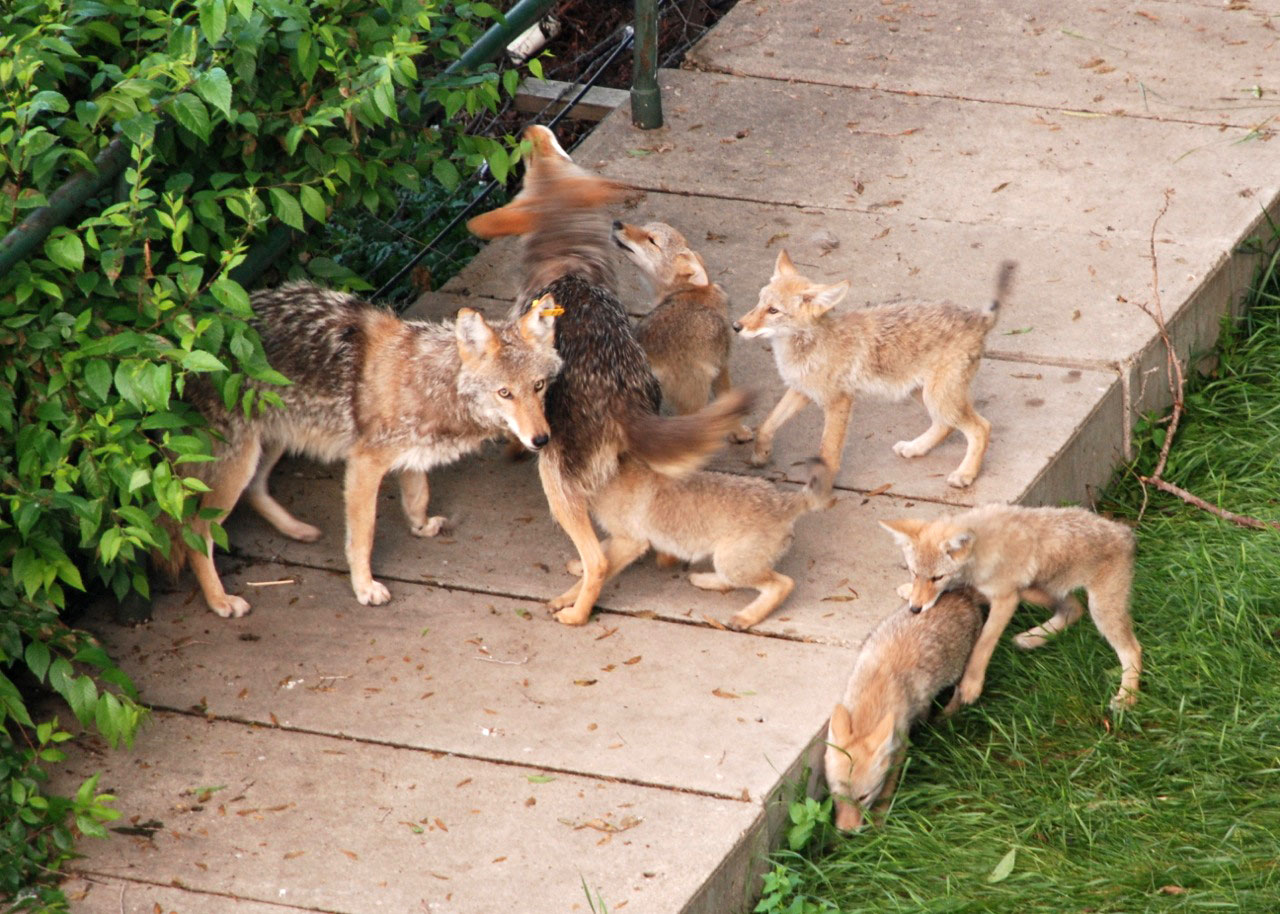
In Edmonton, Colleen St. Clair runs the Urban Coyote Project, a series of multi-year studies about the animals’ behaviour. When she started the project, in the late 2000s, she had only recently begun to work on coyotes. For her post-doctoral research, she linked the catastrophic decline of tufted puffins on the British Columbia coast to climate change. Later, she studied large mammals—bears, elk, and wolves in Banff and Jasper National Parks—which eventually led her home, to Edmonton, and its growing coyote population. She was drawn to the seemingly intractable problem of human-wildlife conflict. “I try to translate that into an opportunity to have this joyful, restorative experience with the natural world,” she told me. “One that changes lives, inspires people, enriches them—and then, incidentally, sustains life on earth.”
In October 2009, St. Clair and her Ph.D. student Maureen Murray live-trapped a coyote near the University of Alberta’s farm, in Edmonton. With the help of Abercrombie’s trapping company, they had already fitted two others with radio and GPS collars, one in the River Valley—the beautiful stretch of parkland along the North Saskatchewan River, which cuts through the city—and one near the Edmonton Valley Zoo. Number one, from the River Valley, was a model of good health, huge and hale, with a thick coat and no sign of illness. The coyotes from more human-dominated areas were in slightly rougher shape. Number three had patches of missing fur on its hind legs, where its skin was marred by mange, a disease caused by parasitic mites that results in hair loss, lesions, and irritation.
Over the next several months, as the scientists used the collars to track the coyotes’ movements, they noticed a few key differences. Number one kept a small, tight home range, staying almost exclusively in natural areas, away from humans. Whenever they caught sight of it, it looked healthy and normal. Number three, on the other hand, was in the throes of a long decline. Although initially it made its home in the Whitemud Ravine, near the farm, its range grew larger, encroaching on residential neighbourhoods. Every time they tracked it down for a visual, number three looked worse: thinner, sicklier, with huge patches of fur gone, the skin red and angry underneath.
Then, that May, they got a call from the local Fish and Wildlife office. Number three was dead. The authorities shot it in the quiet neighbourhood of Allendale, in the middle of the afternoon, as it cowered under a pickup truck. Fish and Wildlife had been getting complaints about the animal almost daily: it was roaming the streets in broad daylight, resting beneath spruce trees on front lawns, showing little fear of humans. It also looked like absolute hell. St. Clair sent it to a colleague at the University of Calgary for a necropsy, and the results were gruesome. A few of the coyote’s ribs were broken, apparently from getting hit by a car. It was blind. It had almost no hair left, and its spinal cord was infected, likely from the gaping sore at the end of its bare, rat-like tail. Its stomach contents were about 70 percent Cheerios.
When coyotes move into the city, many of them blend seamlessly into the urban environment: leery of people, prowling the edges of developed areas, remaining largely unseen during the day. Studies indicate that most rely neither on waste nor pets for food. Instead, they stick to rodents, fruit, deer, and rabbits. Coyotes like number three, though, fall into a bad way, as if lured astray by the sins of the city. St. Clair and Murray observed that one factor seemed particularly important: the presence of compost. They found a correlation between areas that had large volumes of it, such as the zoo and the university farm, and the coyotes they trapped there. “Right away, we noticed that the animals we caught in those locations all had mange, and the coyotes we caught in more natural areas, like the River Valley and the ravines, didn’t have it,” St. Clair said. “That pattern isn’t a perfect fit, but it’s held up as a running average.”
The more coyotes stayed away from people, it seemed, the better off they were. Eventually, the scientists trapped and collared nineteen, eight of which showed signs of mange. Parsing the GPS data, they found that the healthy specimens had small, clearly defined home ranges, which they defended against other coyotes, much as they would outside the city. The mangy ones, on the other hand, had larger ranges—an average of four times the size—and delivered five times as many GPS signals from residential neighbourhoods and commercial zones. As well, coyotes typically are most active at dawn and dusk, but urban coyotes split in opposing directions. Studies show that the most successful among them are nocturnal—an adaptation they develop to avoid humans. By contrast, St. Clair and Murray found, the unhealthy animals were active at all times of day, making them much more likely to come into contact with people. “It’s like there are two types of urban coyotes,” St. Clair said. “Those that live more or less like coyotes live in rural areas, and those that are really dependent on human refuse.”
The researchers set up motion-capture cameras at nine compost sites and at sixteen more natural areas as controls. The coyotes at the compost piles were disproportionately mangy, and many were repeat visitors. They congregated at the piles in surprising numbers—sometimes up to seven at a time—making them more likely to pass parasites between themselves. (Since coyotes are territorial, they would not typically gather like this.) Using stable-isotope hair analysis, St. Clair and Murray determined that mangy coyotes ate 33 percent more anthropogenic—that is, human-derived—food, and 87 percent less prey.
This spring, St. Clair and Murray published their results in the journal Proceedings of the Royal Society B. They identified four key behavioural characteristics of mangy coyotes—a more anthropogenic diet, more daytime activity, larger home ranges, and a higher likelihood of spending time in residential areas—all of which correlate with increased odds of conflict. (Wildlife officials in Edmonton receive about 5,500 coyote-related calls per year, although most are just to report sightings.) St. Clair isn’t sure how this feedback loop begins—that is, whether the animals become sick by eating waste, or whether sick animals are drawn to the easy availability of refuse. The poor nutritional value of compost, the presence of toxins in the rotting material, and rodenticides in the mice at the piles could all conspire to affect the coyotes’ immune systems.3 Since the study’s sample size is relatively small (and limited to Edmonton) it is unclear how generalizable its results are. “We don’t see that at all,” Gehrt said of coyotes in Chicago, when I asked about a possible connection between coyote health, diet, and location within the city. St. Clair, however, is confident about the connection. “Wherever lots of animals are attracted, the spread of disease is going to be higher,” she said.
Environmental measures such as composting and better park systems have unintentionally made our cities more attractive to wildlife. There is real aesthetic and emotional value in an urban landscape that feels more natural. But providing new habitat and food sources to animals means bearing the burden of coexistence. By inviting coyotes into our cities, we have altered their behaviour—and not always for the better. According to a 2004 paper by the biologist Maciej Luniak, many animals in urban areas display a suite of behavioural changes, including living at higher population densities, altered circadian activity, the consumption of human food, and increased tolerance of people—all of which apply to coyotes. Urban animals also have longer lifespans: they survive winter better, have plenty to eat, and face less danger from predators.4 However, this can mean that the populations themselves are less healthy, since wounded or diseased individuals, as well as those with genetic abnormalities, are less likely to die off. Similarly, the availability of scavenged food may keep alive coyotes that would not survive in a more natural setting. “In a place like Edmonton, where you can see these coyotes at minus-thirty degrees, almost no hair, feeding at a compost pile, it’s not really that big of a stretch to imagine this animal would not be able to hunt in these conditions,” Murray said.
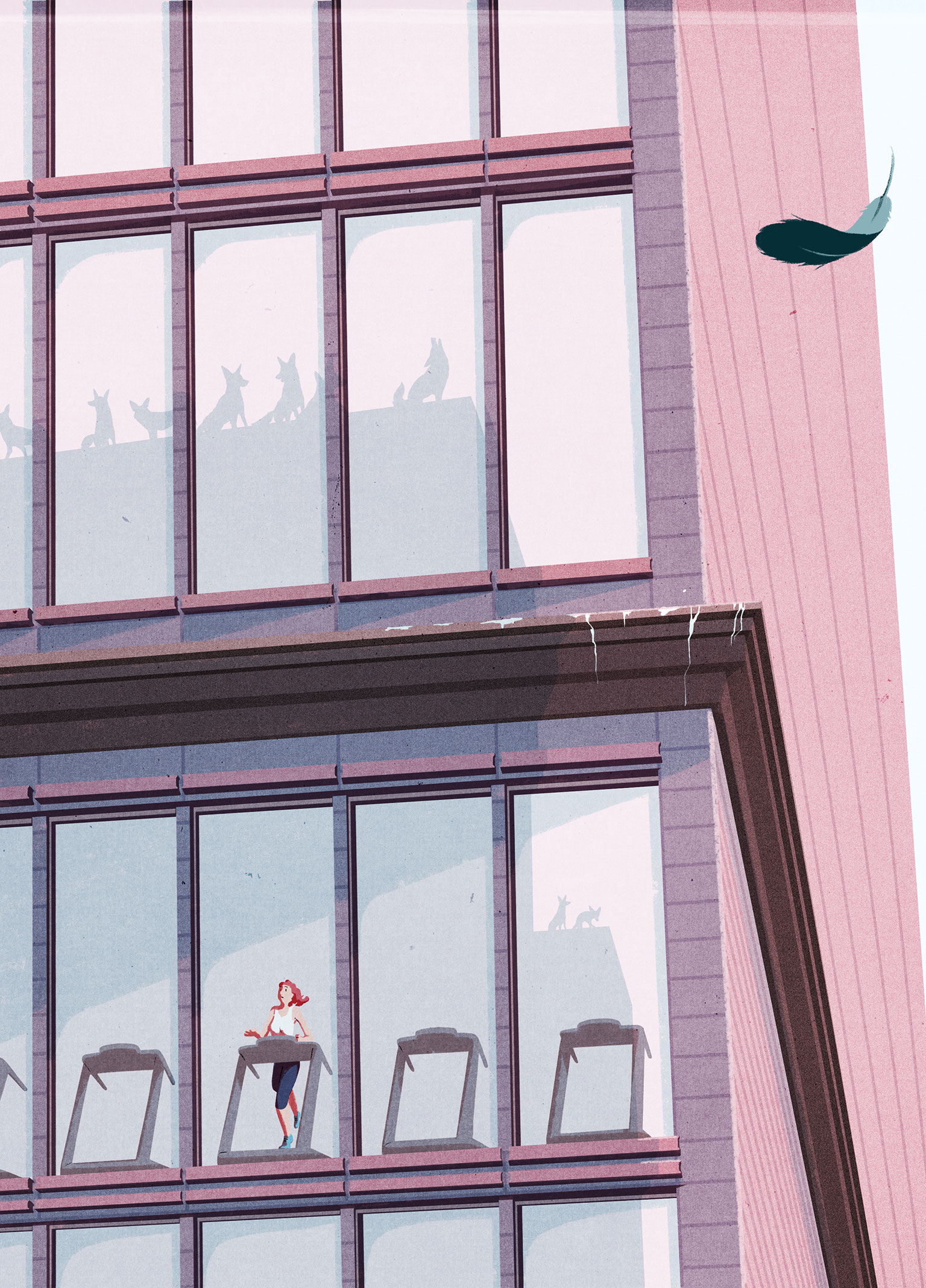
Last fall, early one morning, Murray picked me up in a white University of Alberta SUV. Employees at the Victoria Golf Course, in the River Valley, had told her that at dawn a family of coyotes liked to romp in a copse of spruce trees near the maintenance building. “Golf-course coyotes are top-tier,” Murray said. “Places like the zoo are hubs; there are a lot of transients. But the golf-course coyotes don’t leave.”
When we arrived, magpies flew overhead and chickadees called from the trees, but there were no coyotes. We walked across the fairway to a shed where, in previous years, they had dug a pair of dens. A chewed-up golf ball lay nearby. They seem to be attracted to golf balls; whether that is because they mistake them for reptile eggs or because they use them as toys is unclear.
We got back into the SUV and headed to the zoo. We passed animals in pens—bighorn sheep, Sichuan takins, an emu—before stopping at the compost pit to the west. The heaps were large and exposed, easy to access from the River Valley and the neighbourhoods nearby, making them a magnet for coyotes. It smelled pungent, like a farm: manure and straw. Murray said that two coyotes dwelled in the poplars behind the pit, while more transient animals came and went, using well-trod trails, which, if you zoom in, you can see on Google Earth. In compost piles such as this, coyotes are chiefly interested in rodents, animal feed, and fruit, but they will eat almost anything. Murray has found some strange things in their scat: shoes, window screens, drywall.
She began to assemble a VHF receiver—an antenna attached to a radio. They had collared the coyotes here, a male and a female, earlier in the week, and the collars included both GPS and VHF devices. Right now, though, the receiver was silent. “Doesn’t sound like he’s in the area,” Murray said. I had come to Edmonton to report on a coyote invasion but had yet to see even one. Murray sensed my disappointment and became almost apologetic about their absence, as if it were her fault.
We scrambled up a slope, toward the trees, and Murray showed me the spot where they had trapped one of the animals. Nearby was another pair of dens. I knelt down and peered in. A mushroom bloomed inside. Coyotes frequently have two dens at once, to use as alternates, which they sometimes steal from other animals and then expand. They form monogamous mating pairs or small family groups, with fathers helping to raise the pups.
As we drove back through the zoo, Murray stopped the car. “You hear that? ” she asked. I hadn’t heard anything, but then it came again: a high-pitched wa-wa-wa, like the sound of a coyote yipping. We got out and followed the noise on foot. But now Murray thought it seemed too deep and full-throated to be a coyote, and we located the source. A lone white-handed gibbon sat atop its playground and cried up at the sky.
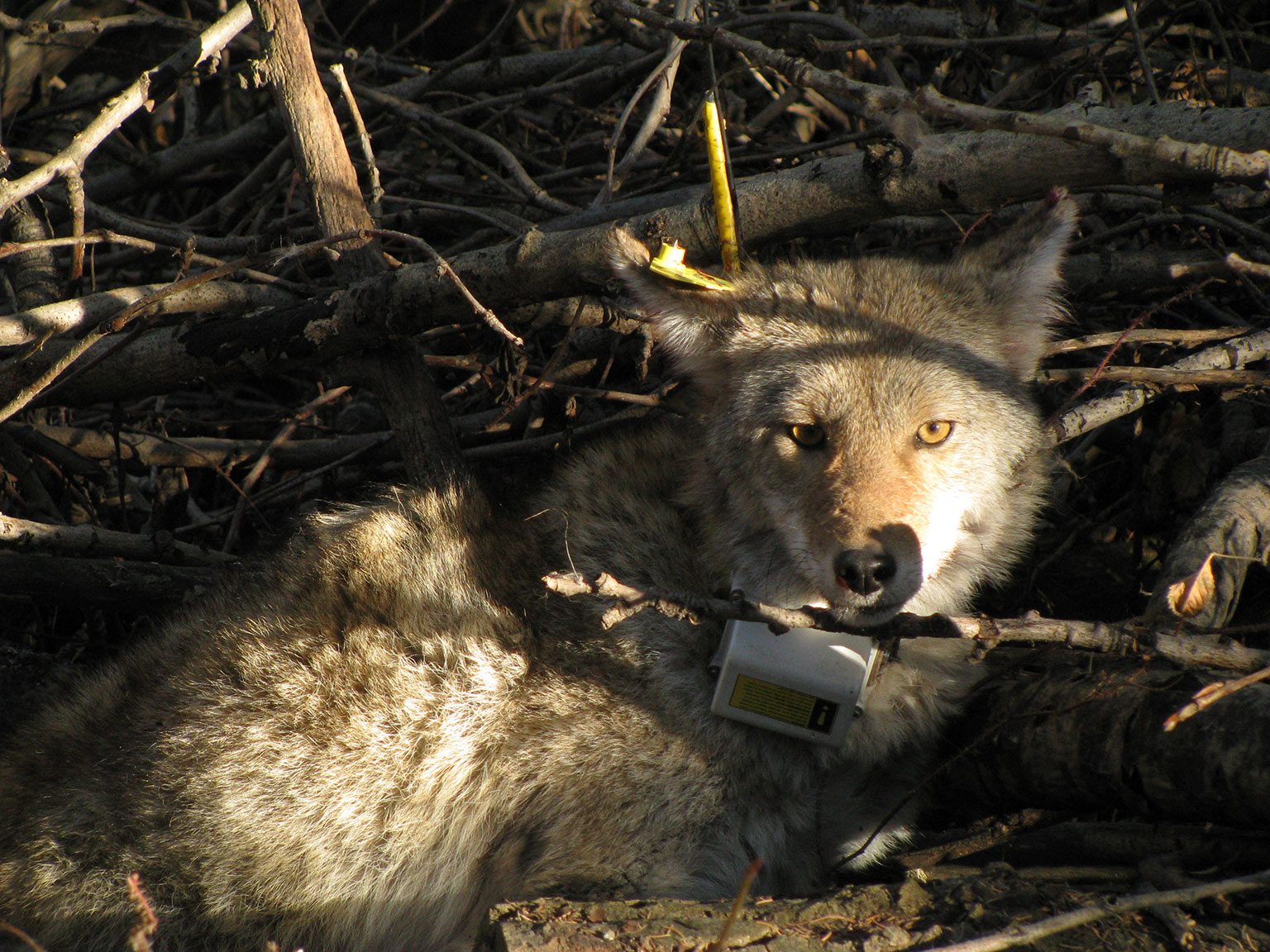
Depending on sex and region, adult coyotes can weigh anywhere between seven and twenty kilograms—smaller than wolves, larger than foxes. Their coats are beautiful, a patchwork of colours: grey, russet, black, tan, cream. Unlike wolves, coyotes are pack animals by convenience rather than by evolutionary necessity. Their diet is mostly made up of small prey—mice, groundhogs, rabbits—but their tastes are catholic. They might eat grass or berries one moment, then band together to take down a deer the next.
Although they are sometimes mistaken for wolves or dogs, coyotes are neither. They are their own species, Canis latrans, and in North America they predate both C. lupus and C. familiaris—not to mention Homo sapiens. Since prehistory, the coyote has been caught in a push-and-pull rivalry with its larger, statelier cousin. The fact that the coyote is more adaptable and more omnivorous, and that it has thrived while the wolf has declined, is no coincidence. It cannot hunt bison or elk the way the wolf can. It lacks the wolf’s sophisticated social structure. It is the gentleman bandit to the wolf’s moneyed nobility. But it was here first.
The fossil record indicates that for a time in the Pleistocene coyotes were nearly everywhere on the continent. They were bigger then and probably ate more meat, but they mostly resembled the animal we know today. Then, perhaps half a million years ago, the Eurasian grey wolf arrived, and the coyotes were beaten back. They headed west, to the wide-open spaces of the plains and the desert. They were patient. They could wait.
The coyote came to occupy a crucial place in the belief systems of many Indigenous peoples. Famously, in myth, he is a trickster, but his foolishness and deceit shape the world we know.5 In a Karuk tale, he is a sort of Prometheus figure, thieving fire from the edge of the world and relaying it downriver. In a Hopi story, he lazily scatters stars across the sky instead of fitting them into constellations. Sometimes he is clever and charming. Sometimes he is bungling and silly. He is also lecherous. In one story, he is caught sucking his own penis; in another, after losing a bet, he listens resentfully as his wife has sex with the beaver. Above all, he steals constantly, instinctively, kleptomaniacally. Claude Lévi-Strauss, the father of structural anthropology, suggested that coyotes play such an important role in these stories because, as omnivorous scavengers, they bridge life and death. They are caught between worlds.
When Europeans arrived, they saw little to admire in “God’s dog,” as Navajo call it. “The coyote is a living, breathing allegory of Want,” Mark Twain wrote. “He is always hungry. He is always poor, out of luck, and friendless.”6 The settlers launched a bloody campaign that more or less has continued to the present day. Like many wars, the war on the coyote has been breathtaking both in its scope and its failure. Over the past few centuries, throughout Canada and the United States, untold millions have been shot, poisoned, trapped, and infected with disease. (Although mange occurs naturally, it was deliberately introduced to the American West in the early twentieth century, in an effort to exterminate wolves.) Government agencies at every level doled out bounties for pelts. Like the wolf, the coyote was considered a threat to livestock and a competitor for game. Unlike the wolf, it knew how to survive. Coyotes sometimes dig up traps and leave them infuriatingly unsprung. Their perseverance is aided by a remarkable reproductive quirk: when their numbers dip, survivors start giving birth earlier in life, more frequently, and to larger litters, pups sprouting like the heads of the Hydra.
In subsequent centuries, European settlers continued to clear the forests, and the wolf population collapsed; at one point, there were only 300 grey wolves in the lower forty-eight US states. The coyotes saw their chance and spread east once more, into a land newly free both of trees and rivals. By the dawn of the twentieth century, they were spotted in pockets of Ontario. Present-day news reports of human-coyote conflicts in Eastern Canada and the US sometimes employ the portmanteau coywolf. In fact, most coyotes in the northeast are coywolves, having interbred with eastern wolves. As a result, eastern coyotes are larger than their western counterparts, with bigger skulls, jaws, and teeth.7 When Ontario suburbanites complain about coyotes the size of German shepherds jogging through their yards, these are the animals they’re talking about.
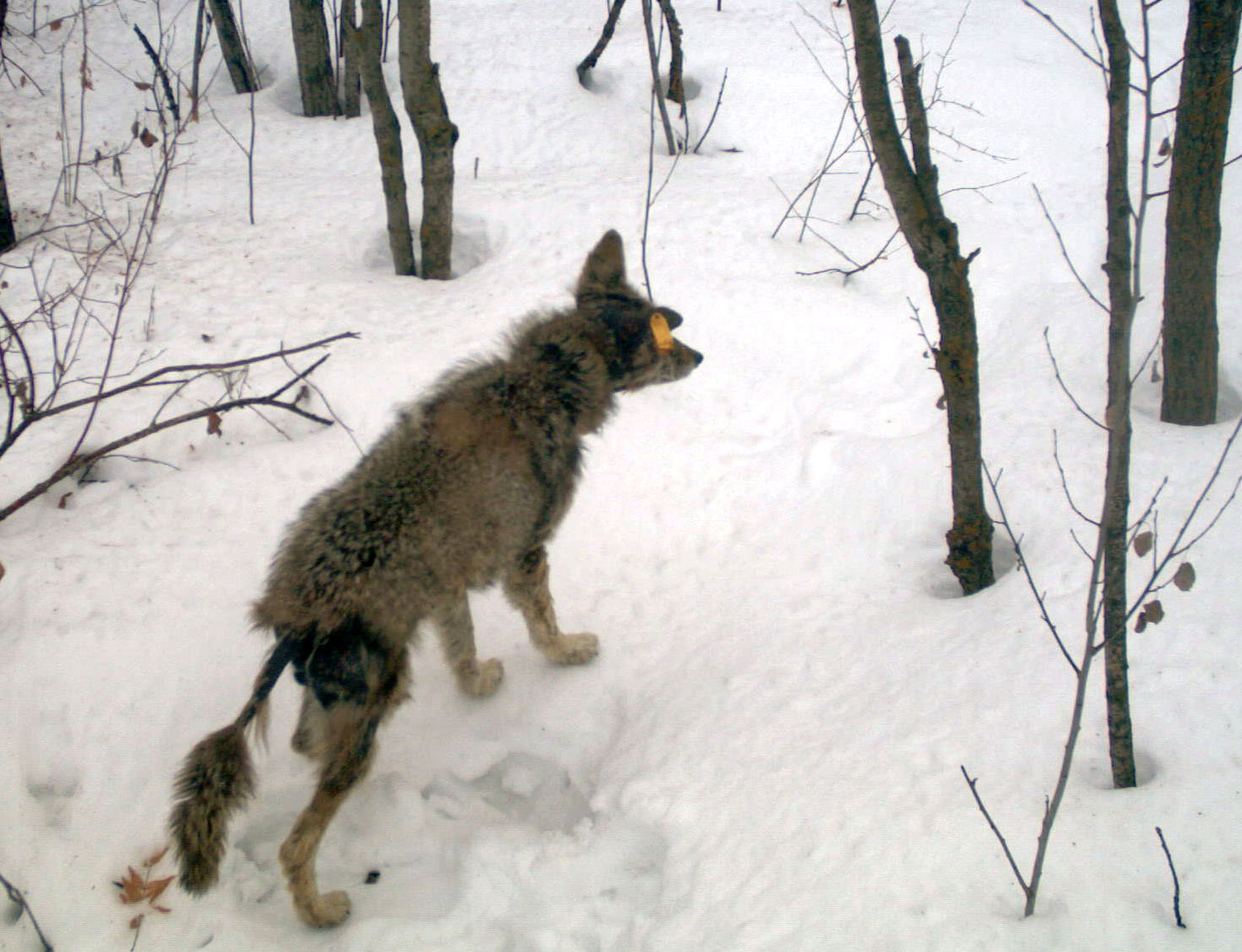
The next morning, Murray and I got up a little earlier and went back to the golf course. We sat in the SUV, watching our breath condense, looking out at the spruce trees. Still no coyotes. Murray called Dave Alexander, the grounds manager, who came to meet us. Alexander was the only person in Edmonton I heard pronounce coyote with a long e, in the eastern manner. He chain-smoked cigarillos as he took us on a tour. “The coyotes moved in here probably six or seven years ago and started thinning out everything else,” he said. “I had twenty-two coyotes down here five years ago, and now we’ve kind of moderated. I have maybe six of this year’s litter. I don’t know what happened to mom and dad.”
Murray asked how the golfers felt about the coyotes. “They’re freaked out by them,” Alexander said. “The way I deal with that is, I just tell them the facts. They think we can catch them and move them out to the farm and give them this healthy, lovely home. When you explain that actually, no, they will kill them, that’s the only option I have—then they don’t mind them so much.”
Policies surrounding the lethal management of problem animals vary. In 2013, the US Department of Agriculture’s Wildlife Services killed more than 75,000 coyotes at the behest of homeowners, farmers, businesses, and other agencies. Canada lacks a single federal body that oversees wildlife management, so it’s difficult to compare numbers. In 2014, Alberta Fish and Wildlife killed nine sick or nuisance coyotes in Edmonton, while Toronto Animal Services euthanized two. Some non-governmental organizations, such as Coyote Watch Canada, oppose most forms of lethal management and offer resources and support for municipalities that want to avoid killing animals. Lesley Sampson, the organization’s executive director, told me that lethal management is overused because residents and officials can’t tell the difference between normal behaviour and aggression. “A lot of the time, there’s an abuse of the lethal option because people don’t know what they’re looking at,” she said. (Not everyone agrees. “The Coyote Watch people have an agenda, which is to protect coyotes and to hell with everything else,” Peters told me.) Some jurisdictions still have bounties on coyotes. Utah has a $50-per-pelt reward; for a few years after the 2009 attack in Cape Breton, Nova Scotia held a $20-per-pelt cull. But because of the coyote’s reproductive talents, the effectiveness of these programs is limited. “Bounties don’t really work,” Dave Linkhart, of the US National Trappers Association, said. “It’s a losing battle.”
Spend time talking to coyote people, and they all say the same thing: don’t feed the animals. Habituation to humans as a food source is the single biggest factor in the creation of nuisance animals. Bylaws against deliberately feeding wildlife and educational programs to discourage the practice would help. But in an era of bird feeders, municipal compost collection, and urban gardening, it’s difficult to eliminate feeding entirely. “Landfills have always existed and have always attracted lots of wildlife,” Murray said. “But now it’s like we took one landfill and broke it into a million pieces and sprinkled it across the city.”
St. Clair believes that aversive conditioning—hazing coyotes with noise and projectiles to instill a healthy fear of humans—could also help. Many national parks employ these techniques, such as firing rubber bullets, to scare off black bears that have become used to people. Although some wildlife managers dismiss aversive conditioning as a waste of time, St. Clair insists it could be done better. “I agree that it does not work in the way it is usually implemented, with a conservation officer armed with a shotgun and rubber bullets or bean bags, who covers a huge area,” she said. Instead, coyotes need to be taught to fear all humans, everywhere, regardless of what they look like or whether they are carrying a weapon. She hopes to start a community-stewardship pilot project in Edmonton, in which residents would volunteer to harass them. “You want coyotes to fear the three-year-old in the playground,” she said, “or the diminutive lady with the diminutive dog.”
In urban areas, coyotes are useful, helping to control rodent populations. Many people simply like having them around. “The majority of our reports are just people telling us about a sighting or experience,” said Dan Straker, the coordinator of the Stanley Park Ecology Society’s urban-coyotes program, in Vancouver. They are the largest wild carnivores that many of us will ever encounter, offering a connection with nature that is rare in an environment dominated by concrete and glass. Conservation biologists call some animals “charismatic”—cute or fascinating or frightening species, such as tigers and pandas, whose public appeal can be channelled toward broader environmental ends. Coyotes could play that role: ambassadors for a new equilibrium with the savage things among us. In any event, we probably don’t have a choice. “Coyotes will eventually decide when and where they’re going to live,” Gehrt told me. “That’s the bottom line.”
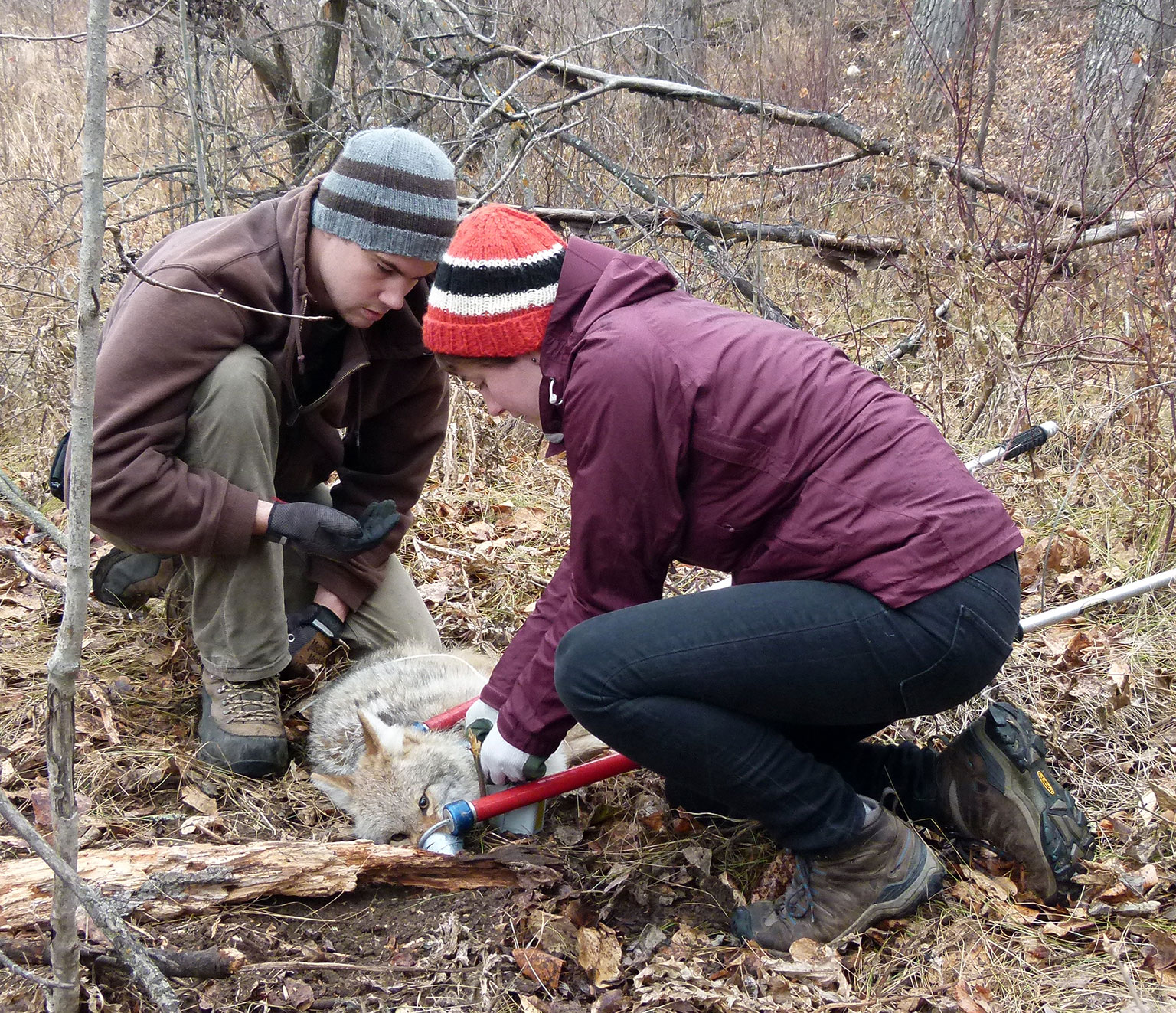
On my final day in Edmonton, at 6:13 a.m., I received a text message from Murray: “Good news! We got a coyote!” The animal had been trapped about an hour earlier, and the motion-sensor camera at the site sent an image to Murray’s phone. We drove to an industrial park in the city’s southeast, a brilliant prairie sunrise of gold and rose and blue on the horizon. Joe Abercrombie, Bill’s nephew, had already arrived in his pickup. We walked through the tall grass toward the trap.
As we approached, Murray and Abercrombie stopped and pointed ahead: a coyote stood in a clearing between two groves of poplars. It barked at us, that distinctive high-voiced yip, and then looked up and barked at a magpie as it flew past. This was likely the mate or sibling or offspring of the one in the trap. We stared at it for a while in a low-stakes standoff, and when we pressed on it turned and trotted away.
We headed into the trees, and I saw the other coyote, its front paw clamped in the padded leg trap. It thrashed and pivoted as we approached. It was smaller than I expected but, according to Murray, large for a western coyote, perhaps two or three years old, healthy looking, with no sign of mange. Its thick winter coat was coming in. Abercrombie picked up a snare pole—a long tube with an adjustable loop at the end—and a branch. The animal crouched in defence as he slipped the snare over its head and prodded the stick between its teeth, to give it something to bite, like someone suffering a seizure.
Once the snare was tight, Abercrombie removed the branch and pinned the coyote to the ground. Murray tightened a second snare pole on its muzzle, then wrapped its jaws shut with duct tape. “They grow up getting dominated by alpha dogs, so they’re used to this,” Abercrombie said.8 (The coyotes are not sedated, to avoid the risk of them wandering groggily into traffic upon release.) It was still, though its eyes were wide. The other animal yipped in the distance.
Murray and Abercrombie spread the coyote’s legs: female, which was a surprise, given its size. They freed its paw from the trap and bound its limbs with sturdy plastic zip ties. Abercrombie picked it up, but it somehow got loose and began to jump and writhe on its trussed legs. He pinned it to the ground again, then hung it upside down from a scale. It was twelve kilograms. Abercrombie put the coyote back down and stood on the pole to keep it there. He snipped some hairs from its neck for analysis. It stared up at him the entire time. This would be coyote number thirty-two.
Murray removed the boxy grey collar from a bag and fastened it onto the coyote, asking me to note its number and radio frequency. She popped yellow tags into the ear-tag gun, which resembled a large pair of pliers. The coyote’s eyes were calmer now, and it gazed off into space, resigning itself to fate. Abercrombie clamped the tag to its ear, which looked like it should be painful, but the animal did not appear to notice.
Her work finished, Murray snipped through the duct tape and peeled it off. She cut the zip ties and stepped back. Abercrombie removed one snare from the coyote’s snout and the other from its neck. It was free. The whole process had taken about twenty minutes.
Though it was no longer tied up, the coyote remained frozen on its side, ears perked and eyes on Abercrombie. Its deference felt dog-like, as if it were awaiting instruction. In that moment it seemed truly liminal, caught between the order of civilization and the lure of the wild. After a few seconds, though, Abercrombie wedged his boot under the animal and lifted. The coyote’s legs unfurled beneath it, and number thirty-two bounded away, into the trees.
The Writers’ Trust of Canada supported the author of this story.
How to Trap a Coyote
One afternoon in Edmonton, Joe Abercrombie, Bill’s nephew, showed me how to set a coyote trap. Maureen Murray and I met him in a residential neighbourhood close to the River Valley. He put on a pair of white cloth gloves and hauled a bucket of frozen beaver trim—fatty meat scraped from the inside of the pelt—out of the back of his pickup truck. As he hacked at the trim with a hatchet, the chunks of flesh produced a reddish mist.
We walked over to the trap site. For several weeks, Abercrombie and Murray had pre-baited it—leaving the meat for coyotes to sniff and eat, so they would become accustomed to the site, which was designed to mimic the caches where coyotes and other animals store food. The bait is placed in a deep hole at the base of a tree, with branches arranged in a V pointing toward it, forcing the coyote to approach it from an angle that (ideally) ensures it steps on the trap.
Abercrombie began to dig, just outside the bait hole, at the nearest possible point. He picked up the trap, which had a circular pan and rubber-padded jaws. (The Urban Coyote Project uses motion-sensor cameras that send photos when triggered, so animals aren’t held for more than a few hours. Trapping also happens in late winter and early fall to avoid catching pregnant mothers or those with young offspring.) “It looks flush, but there’s actually half a centimetre of space here, and the rubber compresses a lot,” he said, indicating the trap’s jaws. “So it doesn’t hurt their leg, even if you get a non-ideal catch, low on the foot.” Abercrombie wound the trap so that animals lighter than coyotes, such as raccoons or skunks, wouldn’t set it off. “You want enough pressure so that he has to commit his full paw to the pan,” he said.
Abercrombie hammered stakes into the ground to hold the trap in place, then picked up a handful of peat moss. “I’ll use this peat moss and put it under the pan so that when you sift the dirt on it, it won’t pack under the pan and keep it from firing,” he said. “Lots of guys don’t use this; they’ll set it in the dirt and then lay wax paper over top. But if the coyote doesn’t step perfectly the first time, it’ll hear the crinkle and back off.” He sifted dirt over the trap, then began brushing the area to create a subtle concave above the pan. He picked up some leaves and twigs and threw them down the bait hole and scattered them around the trap.
Abercrombie then sprayed the site with a series of foul-smelling agents, including trout oil and a lure made of skunk glands. “You could make this look any way you wanted and you couldn’t catch a coyote if it isn’t de-scented properly,” he said. “I’ve had coyotes who just know your trap’s there and, even with a single nail, just scratch until they hit the trap and be like, Yeah, trap’s there, and take off. Or they’ll just uncover your trap completely. It’s amazing.”
The trap was now set, and it smelled terrible. “Looks pretty natural, eh? ” Murray said. It did.
Footnotes
- Although attacks on pets are relatively uncommon, they do happen. Coyotes have a taste for small dogs—Yorkies, Shih Tzus, Jack Russells—but are not picky; earlier this year, a woman in Caledon, Ontario, said coyotes killed and ate her golden retriever. Most scat analyses indicate that cats make up only 1 to 2 percent of the urban coyote diet, dogs even less. In Southern California, coyotes decimated a colony of feral cats and then proceeded to eat the cat food left out by sympathetic humans. It is possible that coyotes kill dogs and cats mainly to eliminate competition for small prey and leave the carcasses uneaten—something they often do with foxes.
- While other parts of the world have not undergone the same changes in land use as North America, the growth of urban wildlife is global. In Mumbai, India—a metropolis of 20 million people—leopards dine on the city’s innumerable stray dogs. In the suburbs and cities of Queensland, Australia, dingoes are growing increasingly brazen in their attacks on people and pets. Red foxes have taken over much of London. Hyenas in Addis Ababa, Ethiopia, have been known to bite homeless people and dig up graves.
- St. Clair and Murray sampled twenty-nine compost sites around the city, of which the vast majority contained mycotoxins—metabolites of fungus that grow on rotting material and can cause an array of health problems in humans and animals. Many mycotoxins are immunosuppressants, which make animals even more vulnerable to parasites and disease. Other scientists have observed an apparent connection between anticoagulant rodenticides and mange in animals such as cougars and bobcats.
- Cities are also warmer than their surrounding areas, something known as the heat-island effect.
- In these stories, the coyote isn’t a coyote as such; instead, he’s one of the First People, a group of demigods who predate humanity. “When humans came into existence, the First People were transformed into the species of animals that still bear their names,” William Bright writes in A Coyote Reader. “The First People were not animals. They more resembled gods, although they were not much like any gods ever worshipped in Europe. If Coyote were to be compared to any divine figure of European tradition, it would be Loki of the Norseman.” It is also worth noting that the trickster figure frequently takes the form of a canid; see, for example, Reynard, the fox of European allegory, or, in India, the jackal.
- Twain’s contempt for the coyote found a mirror in his contempt for Indigenous peoples. The coyote, he wrote, “will eat anything in the world that his first cousins, the desert-frequenting tribes of Indians, will, and they will eat anything they can bite. It is a curious fact that these latter are the only creatures known to history who will eat nitroglycerin and ask for more if they survive.”
- Although wolves and coyotes are natural enemies, eastern wolves were nearly eliminated by hunting and habitat destruction, and their dwindling numbers likely forced them to interbreed with coyotes as their cousins pushed east. Eastern wolves are smaller than grey wolves, and there is scientific disagreement as to whether they are a subspecies of the grey wolf or a separate species entirely. Some scientists believe that eastern wolves actually evolved from the same ancestor as coyotes, rather than from the animals that crossed the Bering Strait and became grey wolves—and are therefore more closely related to coyotes than to grey wolves.
- Coyotes are relatively easy to subdue once live-trapped. “Coyotes are not pack animals, but they do live in territorial groups, and there are dominant coyotes,” Bill Abercrombie told me. “There’s a pecking order there, and the ones that aren’t at the top are constantly being dominated by the one who is. So being caught or restrained and—in their minds—dominated is something they are familiar with.” Interestingly, although red foxes are smaller than coyotes, they are more vicious when trapped, because they are solitary. “They are higher strung and very aggressive animals, so handling them is a big pain because all they want to do is get a piece of you,” Abercrombie said. The opposite is true of wolves: “Amazingly enough, one of the easiest ones to handle is wolves, because they live in a family group and they submit right away. They’re actually easier to handle than even coyotes are.”





